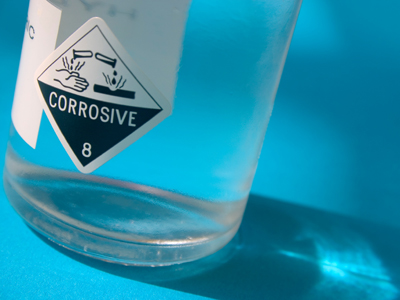In this first quiz on high school Chemistry we take a look at one vital part of the subject - acids, alkalis, bases and salts. In it we find out the difference between alkalis and bases, how acids and alkalis react with one another, how neutralization can produce salts and the relevance of pH values.
Acids and alkalis are incredibly important for manufacturing, and for everyday life. Some examples of things made using acids and alkalis are soaps and detergents, fertilizers, car batteries and medicines - you will have probably learned a lot more examples during your lessons, as well as the properties of acids and alkalis. The most important of the reactions of acids and alkalis is neutralisation. Mixing the correct amounts of acid and alkali will result in a solution that is neutral because the two substances react together to produce water and a salt.
During the 20th century, people knew about air pollution but little was done about it until the final decades. During the 1970s, it was noticed that trees were dying and some lakes were becoming too acidic to support life. It was realized that acid rain was the cause. The first response to this was to try to neutralize the water in lakes by using huge amounts of calcium carbonate (remember, acids react with carbonates as well as with alkalis). Rain is normally very slighly acidic as it contains dissolved carbon dioxide from the air. Acid rain is rain that is much more acidic than normal and it occurs where fossil fuels are being burnt in large quantities. Governments introduced laws that forced the polluters to look at ways of reducing the amounts of acidic gasses in the fumes that they produced. The problem is not as bad as it was then, but it is still with us.
There are several different ways of defining what an acid or an alkali is (alkalis and bases are NOT exactly the same thing. See Q2 for more details). The simplest and probably the first that you learned is the pH. A pH value of 7 is neutral, anything lower than this is acidic and anything more than pH7 is alkaline. Values that are further away from neutral indicate stronger acids and alkalis.
Be careful not to confuse the terms strong and weak with dilute and concentrated. You might think that a strong acid or alkali would always be more harmful than weak acids or alkalis. That is not necessarily the case. Take for example hydrochloric acid. This is a strong acid yet it is found inside your stomach! How can that be? Well, it's a matter of concentration, the hydrochloric acid inside your stomach is extremely diluted. Your stomach acid is so dilute that it is easily contained by a thin layer of mucus secreted by cells in the walls of your stomach.
Finding out whether something is acidic or alkaline can be done in different ways. The substance known as 'litmus' is used simply to find out if a solution is acidic or alkaline, it cannot be used to find the strength of an acid or alkali. Litmus is naturally blue and the dye comes from lichens, which are becoming more and more scarce. It turns red in the presence of an acid. Some other plant colors can be used in the same way - you may have done some experiments with red cabbage extract at high school. Universal indicator (UI) paper is more useful as it can give you a pH reading. The pH scale runs from 0 - 14 but some UI paper only measures from 0 - 12. For the most accurate readings of pH, using a meter is is the best.
Have a go at this quiz and see if your understanding of acids, alkalis, bases and salts is up to scratch








